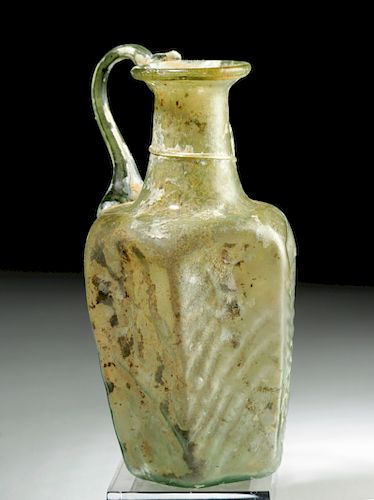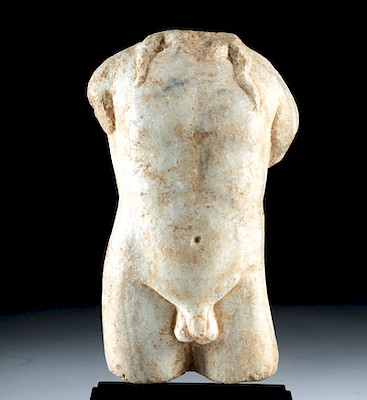Late Roman Glass Pitcher with Molded Body
Lot 59d
About Seller
Artemis Fine Arts
686 S Taylor Ave, Ste 106
Louisville, CO 80027
United States
Selling antiquities, ancient and ethnographic art online since 1993, Artemis Gallery specializes in Classical Antiquities (Egyptian, Greek, Roman, Near Eastern), Asian, Pre-Columbian, African / Tribal / Oceanographic art. Our extensive inventory includes pottery, stone, metal, wood, glass and textil...Read more
Estimate:
$2,500 - $3,500
Absentee vs Live bid
Two ways to bid:
- Leave a max absentee bid and the platform will bid on your behalf up to your maximum bid during the live auction.
- Bid live during the auction and your bids will be submitted real-time to the auctioneer.
Bid Increments
| Price | Bid Increment |
|---|---|
| $0 | $25 |
| $300 | $50 |
| $1,000 | $100 |
| $2,000 | $250 |
| $5,000 | $500 |
| $10,000 | $1,000 |
| $20,000 | $2,500 |
| $50,000 | $5,000 |
| $100,000 | $10,000 |
| $200,000 | $20,000 |
About Auction
By Artemis Fine Arts
Dec 5, 2018
Set Reminder
2018-12-05 10:00:00
2018-12-05 10:00:00
America/New_York
Bidsquare
Bidsquare : DAY 1 | Classical Antiquities & Asian Art
https://www.bidsquare.com/auctions/artemis-gallery/day-1-classical-antiquities-asian-art-3698
Day 1 of an important 2-day auction featuring ancient and ethnographic art from around the world. Egyptian, Greek, Roman, Viking, Near Eastern plus Asian Art from China, Japan, Thailand, Vietnam, Burma, India, more. Artemis Fine Arts info@artemisfinearts.com
Day 1 of an important 2-day auction featuring ancient and ethnographic art from around the world. Egyptian, Greek, Roman, Viking, Near Eastern plus Asian Art from China, Japan, Thailand, Vietnam, Burma, India, more. Artemis Fine Arts info@artemisfinearts.com
- Lot Description
Roman, later Imperial Period, ca. late 3rd to 4th century CE. A fine mold-made glass pitcher of a transparent, pale-green color with a slight concave base, a tall, hexagonal-sided body, a rolled shoulder with a tubular neck, an everted and in-folded rim, and a wide applied trail handle joining rim to shoulder. The handle, made from a seafoam-hued glass, was applied and then double-folded before it was attached to the underside of the rim. The body has a dimpled, mold-formed texture. Pretty pearlescence is on the surface. Size: 2.9" W x 5.2" H (7.4 cm x 13.2 cm)
Most scholars agree, Roman glass was of the highest quality - both aesthetically and technically - among the ancients. While glass making had been practiced for centuries, glass blowing was invented in the Roman-controlled Holy Land in the 1st century BCE. This innovative technology revolutionized the artform. We can appreciate such a wide variety of forms and shapes, because the medium of glass has unique physical properties that make for so many more possibilities which would eventually replace a wide variety of pottery and metal wares in the ancient world. Roman glassmakers reached incredible artistic heights with both free-blown vessels and mold blown forms and decorations and were traded far beyond the Roman Empire. Roman glass vessels have been found in Scandinavia, India, and in Han Dynasty tombs in China.
Provenance: private East Coast, USA collection
All items legal to buy/sell under U.S. Statute covering cultural patrimony Code 2600, CHAPTER 14, and are guaranteed to be as described or your money back.
A Certificate of Authenticity will accompany all winning bids.
We ship worldwide and handle all shipping in-house for your convenience.
#133195Neck/mouth has been repaired. One side of the vessel has a large, stable crack on its exterior. Pearlescence on surface, with some deposits visible on the interior. No pontil mark as this vessel is mold-made.Condition
- Shipping Info
-
All shipping is handled in-house for your convenience. Your invoice from Artemis Gallery will include shipping calculation instructions. If in doubt, please inquire BEFORE bidding for estimated shipping costs for individual items.
-
- Buyer's Premium



 EUR
EUR CAD
CAD AUD
AUD GBP
GBP MXN
MXN HKD
HKD CNY
CNY MYR
MYR SEK
SEK SGD
SGD CHF
CHF THB
THB
















